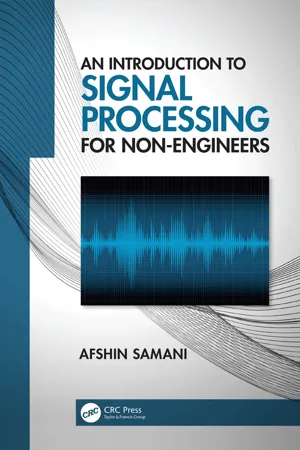Exponential Form of Complex Numbers
The exponential form of complex numbers represents a complex number in terms of its magnitude and angle. It is expressed as re^(iθ), where r is the magnitude and θ is the angle. This form is useful for simplifying complex number operations, such as multiplication and division, and for understanding the geometric properties of complex numbers.
6 Key excerpts on "Exponential Form of Complex Numbers"
- eBook - ePub
Digital Signal Processing 101
Everything You Need to Know to Get Started
- Michael Parker(Author)
- 2017(Publication Date)
- Newnes(Publisher)
...This will become important in digital communication, because it can be used to compute the power of a complex signal. To summarize, we have tried to show that the imaginary numbers which are used to form things called complex numbers are really not so complex, and imaginary is really a very misleading description. What we have really been after is to create a two dimensional number plane, and define a set of expanded arithmetic rules to manipulate the numbers in it. Now we are ready to move onto the next topic, the complex exponential. Figure 2.4 Complex conjugate diagram. 2.6. The Complex Exponential The complex exponential has an intimidating sound to it, but in reality, it is very simple to visualize. It is simply the unit circle (radius = 1) on the complex number plane (Fig. 2.5). Any point on the unit circle can be represented by “e” or raised to the power (j·angle) or more also expressed e jΩ, which is called a complex exponential function. A few examples should help. Let the angle Ω = 0°degree. Anything raised to the power 0 is equal to 1. This checks out, since this is the Point 1 on the positive real axis. Let angle Ω = 90°degrees. The complex exponential is e j90. This is the point j on the positive imaginary axis. We need a way to evaluate the complex exponential to show this. This leads to the Euler equation. This equation can easily be derived using series Taylor expansion for exponential, but we have promised to minimize the math. But the result is: e j Ω = cos (Ω) + j sin (Ω) Let us try exp(j90) again. Using Euler equation e j 90 = cos (90) + j sin (90) = 0 + j · 1 = j Imagine the point Z = e jΩ with the angle Ω starting at 0°degree and gradually increasing to 360°degrees. This will start at the point +1 on real axis, and move counter-clockwise around the circle until it ends up where it started, at 1 again...
- Afshin Samani(Author)
- 2019(Publication Date)
- CRC Press(Publisher)
...Based on trigonometric equations, it is very straightforward to show that for a complex number c = a + i.b R = a 2 + b 2 and θ = atan (b a) ; This is how the real and imaginary parts of a complex number are related to its magnitude and phase. For a complex number like c = a + i.b, a complex-conjugate number is defined as c * = a − i.b. Here, c * is the complex-conjugate (or just conjugate) of c. The conjugate has some nice properties—for example, the multiplication of c and c * equals the magnitude of c squared. In the polar representation c * = Re − iθ, the conjugate has the same magnitude, but its phase has the opposite sign to the complex number c....
- eBook - ePub
- Arsen Melkumian(Author)
- 2012(Publication Date)
- Routledge(Publisher)
...If a point A represents z = a + bi on the complex plane, then the distance from the origin O to the point A is the modulus of z Note that compex conjugates have the same modulus: E XAMPLE 11.4 (a) |3 + 4 i | = 5 (b) |3 − 4 i | = 5 (c) (d) Using complex numbers we can solve any quadratic equation. Recall that the solution for ax 2 + bx + c = 0 is given by where We can use the formula over the complex numbers even when the discriminant D is negative. E XAMPLE 11.5 Solve Solution : E XAMPLE 11.6 Prove that. Solution : Let z 1 = a + bi and z 2 = c + di. Then E XAMPLE 11.7 Show that. Solution : Let z 1 = a + bi and z 2 = c + di. Then 11.2 Polar and trigonometric form of complex numbers So far we have discussed the so-called Cartesian representation of the complex numbers. In essence, we have assigned to each complex number a point on the Cartesian (or complex) plane. However, complex numbers have also a representation in polar coordinates. A complex number z = a + bi is assigned coordinates (r, θ) in the polar system, where and θ is such that as shown in Figure 11.3. The pair (r, θ) specifies a unique point on the complex plane. However, a given point on the complex plane does not have a unique polar representation. In fact, a point z = (r, θ) has infinitely many polar representations of the form z = (r, θ + 2 πn), with n ∈ ℤ. A number in the form (θ + 2 πn) is called an argument of z. The argument of z lying in the range (−π, π] is referred to as the principal argument of z or Arg(z). For instance, the principal argument of 2 i is and the principal argument of (2 i + 2) is Figure 11.3 A complex number z can also be written in a trigonometric form: The trigonometric form of complex numbers is used extensively in time-series analysis. E XAMPLE 11.8 Find the trigonometric form of z = 2 + 2 i. Solution : It follows that Hence Complex numbers can also be written in an exponential form...
- eBook - ePub
Digital Signal Processing
Fundamentals and Applications
- Li Tan(Author)
- 2007(Publication Date)
- Academic Press(Publisher)
...F Some Useful Mathematical Formulas Form of a complex number: (F.1) (F.2) (F.3) Conversion from the polar form to the rectangular form: (F.4) Conversion from the rectangular form to the polar form: (F.5) We usually specify the principal value of the angle such that −180° < θ ≤ 180°. The angle value can be determined as: (that is, the complex number is in the first or fourth quadrant in the rectangular coordinate system); (that is, the complex number is in the second quadrant in the rectangular coordinate system); and (that is, the complex number is in the third quadrant in the rectangular coordinate system). Note that Complex numbers: (F.6) (F.7) (F.8) Complex conjugate of a + jb: (F.9) Complex conjugate of Ae j θ : (F.10) Complex number addition and subtraction: (F.11) Complex number multiplication: Rectangular form: (F.12) (F.13) Polar form: (F.14) Complex number division: Rectangular form: (F.15) Polar form: (F.16) Trigonometric identities: (F.17) (F.18) (F.19) (F.20) (F.21) (F.22) (E.23) (F.24) (F.25) (F.26) (F.27) (F.28) (F.29) Series of exponentials: (F.30) (F.31) (F.32) (F.33) L’Hospital’s rule : If results in the undetermined form or, then (F.34) where and. Solution of the quadratic equation: For a quadratic equation expressed as (F.35) the. solution is given by (F.36)...
- eBook - ePub
- Frank J. Fahy(Author)
- 2000(Publication Date)
- Academic Press(Publisher)
...(A1.1b) shows that (A1.4a) (A1.4b) (A1.5) and (A1.6) The function à exp (j ω t) may be represented in the complex plane by a rotating vector called a ‘phasor’, illustrated by Fig. A1.1 The projection of the phasor on the real axis represents the real quantity f (t). The time-independent vector represented by the complex number à is the ‘complex amplitude’ of the harmonically oscillating quantity. (In this book, a complex amplitude is signalled by the ‘tilde’ placed over the symbol representing the quantity: it has the units and dimensions of that quantity.) The time-independent vector à is multiplied by the unit vector e j ω t rotating anti-clockwise at speed ω, which is the angular frequency of the harmonic function (unit: rad s −1). Fig. A1.1 Complex Exponential Representation of Harmonic Signals by Phasors. In fact, it would be more logical to avoid the necessity to extract the real part of the resulting phasor by taking the average of the sum of counter-rotating phasors of complex amplitudes à = a + jb and à * = a - jb, which, as shown in Fig. A1.2, is always real. This form of CER is sometimes employed in theoretical analysis and is basic to Fourier analysis, in which both positive and negative frequencies are used (see Appendix 2). However, the following sections are based upon only the positive frequency convention, which is more commonly taught and employed in schools of mechanical engineering. Fig. A1.2 Counter-rotating Phasors. A1.2 Harmonic functions of space Plane waves that are generated by a harmonic source in a linearly responding medium have spatially harmonic distributions, provided that the phase speed c ph is everywhere constant. The distance travelled by a wavefront during one temporal period T = 2π/ω is one spatial period, or wavelength λ, given by λ = 2π c ph /ω. By analogy with temporal angular frequency, spatial angular frequency is given by 2π/λ = ω/ c ph...
- eBook - ePub
Mechanical Vibration
Analysis, Uncertainties, and Control, Fourth Edition
- Haym Benaroya, Mark Nagurka, Seon Han(Authors)
- 2017(Publication Date)
- CRC Press(Publisher)
...Appendix A Mathematical Concepts for Vibration “We are reminded of the essential rules.” This appendix presents mathematical concepts that may be helpful to those studying vibration. It is not meant to be a substitute for courses covering linear algebra, calculus, and differential equations. We assume that the reader has had some experience with the topics. A.1 Complex Numbers A complex number z = x + iy is the sum of a real part x and an imaginary part iy, with x and y both real and i = - 1. The complex conjugate of z is x - iy. Complex numbers, which arise in many scientific disciplines, are needed in the general solution polynomial equations, including of quadratic equations. Before the 18th century, complex numbers and the square root of minus one were in regular use. 1 The equation 2 e i θ = cos θ + i sin θ is credited to Euler and is known as Euler ’ s formula. A.1.1 Complex Number Operations Two complex numbers are added or subtracted by simply adding or subtracting their corresponding real and imaginary parts. For example, the sum of 8 + 3 i and 6 + 3 i is 14 + 6 i. Complex number multiplication is similar to real number multiplication. For example, (x + i y) (u + i v) = (x u - y v) + i (x v + y u). In division of complex numbers, the convention is to express the fraction such that there is no imaginary part in the denominator. This can be accomplished by multiplying the numerator and denominator of the complex fraction by the complex conjugate of the denominator u - iv to find (A.1) x + i y u + i v = (x u + y v) + i (- x v + y u) u 2 + v 2 Example A.l Rewrite the complex fraction 1 - 2 i 7 + 3 i into its real and imaginary parts. Solution: To express the fraction in terms of its real and imaginary parts, multiply its numerator and denominator by the complex conjugate of the denominator and expand as...





